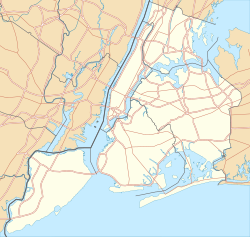Governors Island, New York
|
Governors Island
|
|

Governors Island viewed from One World Observatory
|
|
| Location | New York City, New York, U.S. |
|---|---|
| Coordinates | Coordinates: 40°41′29″N 74°0′58″W / 40.69139°N 74.01611°W |
| Area | 172 acres (70 ha) |
| Architectural style | Colonial Revival, Greek Revival |
| Visitation | 443,000 (2010) |
| NRHP Reference # | 85002435 |
| Significant dates | |
| Added to NRHP | February 4, 1985 |
| Designated NHL | February 4, 1985 |
| Designated NMON | January 19, 2001 |
Governors Island is a 172-acre (70 ha) island in New York Harbor, approximately 800 yards (732 m) from the southern tip of Manhattan Island and separated from Brooklyn by Buttermilk Channel, approximately 400 yards (366 m). It is part of the borough of Manhattan in New York City. The National Park Service administers a small portion of the north of the island as the Governors Island National Monument, while the Trust for Governors Island operates the remaining 150 acres, including 52 historic buildings. Today, Governors Island is a popular seasonal destination open to the public between May and September with a 43-acre public park completed between 2012-2016, free arts and cultural events, and recreational activities. The island is accessed by ferries from Brooklyn and Manhattan.
The Native Americans of the Manhattan region referred to the island as Paggank ("nut island"), likely after the island's plentiful hickory, oak, and chestnut trees; the Dutch explorer Adriaen Block called it Noten Eylant, a translation, and this was borrowed into English as Nutten Island. The island's current name, made official in 1784, stems from the British colonial era, when the colonial assembly reserved the island for the exclusive use of New York's royal governors.
In 1776, during the American Revolutionary War, Continental Army troops raised defensive works on the island, which they used to fire upon British ships before they were taken. From 1783 to 1966, the island was a United States Army post, and from 1966 to 1996 the island served as a major United States Coast Guard installation. About 103 acres (42 ha) of fill was added to the island by 1912, making the island a 172-acre (70 ha) island.
...
Wikipedia



